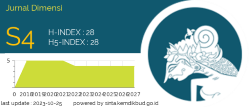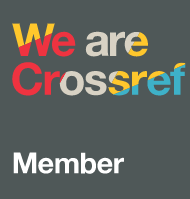THE EFFECT OF DICTOGLOSS METHOD TOWARDS STUDENTS’ LISTENING COMPREHENSION AT THE SECOND GRADE OF SMA NEGERI 16 BATAM
Abstract
Listening is one of the most important skill since more than 45% of communicating time is spent listening. Based on that fact, teacher should put high concern on applying effective teaching strategies to develop listening ability. Dictogloss method can give benefit to develop the students’ listening comprehension. It involves top-down and bottom-up activities which encourage students to hear some sounds, hold them in their working memory, and then interpret what they’ve just heard before something new comes along. At the same time, listeners are using their background knowledge.
The problems solved in this study were that students still got difficult in understanding spoken English, most of students did not understand the instruction when teacher used spoken English, and some teachers still used conventional method to teach listening. This study used the design of pre-experimental. The subject of the study was the second grade students’ of SMA Negeri 16 Batam. The experimental group was taught listening by using dictogloss method, while the control group got treatment from the teacher’s conventional method.
The result of the test was analyzed by using t-test formula with the significance level 5%. From the analysis, the writer found that t-test was greater than t-table, namely 14.45>1,980. Thus, it can be concluded that there is a significant effect of dictogloss method towards students’ listening comprehension.
Based on the result of this research, it is concluded that there is a significant effect of dictogloss method towards students’ listening skill at the second grade of SMA Negeri 16 Batam in academic year 2013/2014. The research finding implies that dictogloss method is applicable to increase the second grade students of senior high school’s listening comprehension. The activity of dictogloss can be as input in scheduling listening class of the English curriculum for Senior High School. This method might give contribution to support students’ skill in writing. Therefore, the writer suggests the English teacher should use dictogloss method to teach listening, the other researchers are suggested to carry out further studies about the use of dictogloss method and the other strategy in developing students’ listening comprehension, and students should learn how to accommodate differences in ability.
Full Text:
PDFReferences
Ambarita, Jenri. 2011. Penerapan Konseling Pastoral terhadapPerubahan Perilaku Korban Narkoba di Rehabilitasi Nazar Ministry. Thesis. Sekolah Tinggi Theologia Global Misi.
Brown, Steven. 2006. Teaching Listening. United States of America: Cambridge University Press.
Emzir. 2012. Metodologi Penelitian pendidikan: Kuantitatif dan Kualittif. Jakarta: PT Rajagrafindo Persada.
Fatmawati. Gilang. 2013. Analisis Produk dan Kualitas Pelayanan terhadap Keputusan Pembelian di Lisung The Dego Boutique Resto Bandung. Thesis. Universitas Pendidikan Indonesia.
Harris, David P. 1969. Testing English as a Second Language. United States of America: McGraw-Hill.
L.R., Gay, dkk. 2009. Educational Research: Competencies for analysis and applications. New Jersey: Pearson Education Inc.
Margono, S. 2007. Metodologi Penelitian Pendidikan. Jakarta: Rimeka Cipta. Norfleet, Michele. 2014. Factors That Affect Listening Comprehension. (http://education.seattlepi.com, accessed date on 10th March 2014 at 21:00)
Oktaviani, Erni. 2013. Efektivitas Teknik Permainan Lompat Jingjat Untuk Meningkatkan Penguasaan Kata Bantu Bilangan Universitas Pendidikan Indonesia. Thesis. Universitas Pendidikan Indonesia.
Vasiljevic, Zorana 2010. Dictogloss as an Interactive Method of Teaching Listening Comprehension to L2 Learners. Japan: Fakulty of Literature, Bunkyo University.Vol.3.No. 1. March 2010. p. 43-45.
Rost. M. 2002. Teaching and Researching Listening. London, UK: Longman.
Saricoban, Arif. 1999. The teaching of Listening. V.5. No. 5. December 1999. P.1.
Wipf. J (1984). Strategies for Teaching Second Language Listening Comprehension. Foreign Language Annals 17:345-348.
Patel, M.F.& Preven M. Jain. 2008. English Language Teaching. Jaipur: Sunrise.
Borg W. & Gall D. M. 2003. Educational Reseach. New York: Longman.
Riduwan & Sunarto. 2012. Pengantar Statistika. Bandung: Alfabeta.
Riduwan. 2005. Statistika Pendidikan. Bandung: Alfabeta.
Wajnryb, Ruth. 1990. Grammar Dictation. Oxford: Oxford University Press.
DOI: https://doi.org/10.33373/dms.v5i3.63
Refbacks
- There are currently no refbacks.











